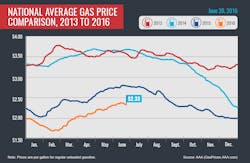Gas Prices Drop For Nine Consecutive Days
Gas prices have fallen for nine consecutive days, reaching today’s average of $2.33 per gallon, according to AAA. Gasoline demand remains on track to set a new all-time high for the 2016 summer driving season, however, crude oil remains relatively less expensive than recent years which is contributing to direct savings at the pump. Drivers are saving a nickel per gallon on the week, but are paying five cents per gallon more on the month. Averages are down 46 cents per gallon versus this same date last year, attributed year-over-year surpluses, and these savings are likely to continue as supply appears more than capable of keeping pace with growing demand.
Pump prices generally peak during the summer months, due to imbalances in supply and demand. Unlike many recent years, supply appears to be meeting the growing demand and as a result prices have held relatively steady and markedly lower than one year ago. On the whole, refineries are keeping up with growing demand and the latest data from the U.S. EIA shows that the market is well supplied. Additionally, expectations of increased production from Western Canada and the U.S. are likely to keep global crude oil prices relatively lower. The combination of the abovementioned factors is contributing to prices at the pump remaining at some of their lowest levels since 2005, and these comparative savings should persist, barring and major disruptions in production or supply.
Quick Stats
- The nation’s top five most expensive markets are: California ($2.86), Hawaii ($2.75), Alaska ($2.68), Washington ($2.65), and Michigan ($2.59).
- The nation’s top five least expensive markets are: South Carolina ($2.03), Mississippi ($2.07), Arkansas ($2.09), Oklahoma ($2.09) and New Jersey ($2.11).
- Prices are down double-digits in several Great Lake States week-over-week—Ohio (-18 cents), Indiana (-18 cents) and Michigan (-15 cents)—following a string of unplanned refinery issues and distribution challenges that had caused prices to jump over the past several weeks. Full report.
